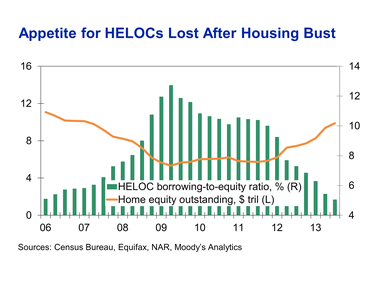HELOC Shock: The Housing Boom's Distant Echo
Thousands of U.S. homeowners face a potential payment shock on home-equity credit lines in 2014.
Monthly payments on HELOCs could rise sharply depending on their terms, and some borrowers will default.
Although house prices have risen substantially since the market bottomed, some may lack the equity needed to refinance.
The fallout will be limited, in part because lenders limited HELOCs to borrowers with high credit scores.
Lenders have also been proactive in modifying loans and are in good shape to weather any losses.
In the runup to the U.S. housing bubble, lenders aggressively issued home-equity lines of credit. Homeowners used these to help finance expenses from home improvement to education and medical bills. Houses were tapped like ATMs, turning windfall equity gains into cash. For many, HELOCs replaced regular credit cards; lenders allowed consumers to use special checks or even plastic cards to draw on their credit lines.
Such practices ended after U.S. house prices crashed in 2007 and 2008. Not only did home equity evaporate, but homeowners’ use of HELOCs changed dramatically. Even as house prices turned upward again, creating nearly $4 trillion in home equity for homeowners in 2012 and 2013, the use of this equity to finance other spending declined each year. By the third quarter of 2013, the ratio of borrowing to equity was 5%, down from a recession peak of 12%.

Although much has changed, the practices of the boom years continue to play a role in some households' finances. Specifically, those who took out HELOCs and ran up balances will face potential payment shocks when the 10-year draw period typically associated with such credit lines ends and the repayment period begins.
The 10-year switch
A typical HELOC allows a borrower to draw on it for 10 years, during which only the interest needs to be repaid. After that, the credit line becomes a self-amortizing loan with principal payments lasting either 10 or 20 years, although some loans require a balloon payment at the end of the draw period.
For U.S. homeowners with active HELOCs first set up in 2004, payments are due to rise sharply next month. According to CreditForecast, nearly 5 million credit lines were originated that year; in 2013, nearly 900,000 are still active, with an aggregate outstanding balance of $40 billion. That averages to $45,000 per household, which up to now would have meant an average monthly payment of $220.
HELOCs were typically issued with adjustable interest rates tied to the prime rate. Since the prime rate is unlikely to move up from its current 3.25% soon, these borrowers won't see their HELOC rates rise sharply with the new year. But payments will still rise as those credit lines enter their repayment periods. If the HELOC was issued with a 20-year term, the jump could be steep, to $390 per month. Payments on credit lines with 30-year terms will rise much less, to only $240 per month.

Although the housing bubble was a time of notoriously loose lending standards, HELOCs typically are of higher credit quality than first-lien mortgage loans. This is because only a small proportion of HELOCs is securitized. Lenders keep these loans on their books; therefore, they were usually extended only to those with high credit scores. According to CreditForecast, even before the recession, nearly 80% of HELOCs were issued to borrowers with scores above 700.

Balloon payments could be a source of distress. In the past, those who faced such one-time lump-sum repayments, and who still had sufficient equity in the house, could typically refinance through a new HELOC. Although house prices have risen 15% to 20% since the market hit bottom in 2011, some borrowers could still find it hard to replace their credit line.
Lenders turn proactive
The ability to refinance depends on the willingness of lenders. After they took big losses on consumer loans following the housing crash and financial crisis, many banks took a proactive approach to loan modifications. This suggests that many lenders will survey their HELOC customers and take steps to modify their credit terms when they see high default risk. Borrowers with balloon payments could be given new HELOCs or personal loans, or even credit cards to facilitate repayment.
According to CreditForecast, from 2.5% to 3% of HELOC accounts were closed monthly between 2010 and 2013, as borrowers paid their credit lines off in full as soon as the draw period ended. Out of the 900,000 active HELOCs set up in 2004, nearly 250,000 will be either paid off or refinanced next year.

Despite lenders' modification efforts, losses have tended to rise on HELOCs after the repayment period begins. According to CreditForecast, banks’ loss rates have historically doubled in the first two years after a payment reset. This suggests that banks will charge off nearly $1 billion in the first two years after the $40 billion in outstanding 2004 HELOCs enter their repayment period.
Banks can handle it
This is not cause for concern; U.S. banks are well-capitalized, highly liquid and able to absorb losses of this magnitude. The Federal Reserve's recent stress tests have caused lenders to increase their tier-1 capital ratios to 9% currently, significantly above the post-World War II average. This means less stress on bank balance sheets.
Lenders’ willingness to work though distressed loans with borrowers, the housing rebound, and stronger household balance sheets make it likely that any 2014 HELOC payment shock will have limited financial fallout.
Mustafa Akcay is an Assistant Director at Moody's Analytics.
More from Dismal Scientist:
